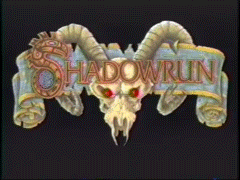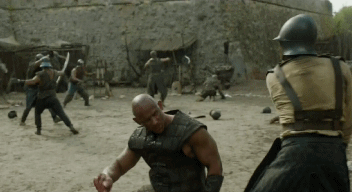Photo







some gifs from an amazing 1990 promo video for the tabletop rpg shadowrun
4K notes
·
View notes
Note
Hey there, any advice on how to make a gladiator style boss rush not feel bland? Like players are fighting for their lives in an arena. I feel like after a few rounds it'll get old and that's the last thing I want to do to them
You got it.
So I reached out to @eagererudite for more context. This situation involves an actual gladiatorial arena with spectators and judges. Also, they’re using D&D 5e.
How to make arena combat engaging in D&D

First, a brief aside on game design and the intent of combat in D&D:
There’s two equally valid ways to approach combat in general, old school and new school.
In old school games (OD&D, AD&D, OSR), combat is treated like a puzzle to be solved through improvisation, cooperation, player skill, and creative thinking. Most PC’s are at a mechanical disadvantage when up against monsters; they don’t have the hit points or the attack bonuses to make straightforward “let’s hit each other with swords until one of us falls down” combat a tenable solution. You have to be crafty, or your character will most likely die.
New school games (D&D 5e, Pathfinder, DW, etc) levels the playing field between PC’s and monsters. More mechanical combat options are available to all characters, not just fighters. Encounters are typically balanced to be “fair” or “equal”. Just straight up fighting enemies is no longer an un-winnable situation, because the focus is shifted from “player skill” to “avatar skill”.
I bring this up because my advice is rooted more firmly in the old school approach. I think its application is better suited to life or death arena combat.
So how do you present arena combat as being interesting in a D&D game?
Well, I think it’s best to go all in on what a gladiatorial fight involves:
Games where combatants must fight each other under specific circumstances.
Opponents from all walks of life: slaves or prisoners just trying to survive, ex-soldiers trying to make it big, and celebrity gladiators who’re at the top of their game.
Games pitting unarmed or disadvantaged fighters against exotic beasts or animals.
A wild and rowdy crowd, cheering on their favourites and booing the losers, reacting to what the fighters do.
Rough, bloodstained terrain filled with obstacles, traps, and cover.
A capricious judge (or judges) who listens to the crowd before making the final judgment whether a contestant lives…or dies!

The players should be at a disadvantage here. This isn’t their home turf, and they shouldn’t (immediately) have their usual weapons or spell components. You need to be clear with them: Life is cheap in the arena. If they don’t improvise or fight smart…they WILL die.
My advice is to have the encounters focus less on back and forth fighting and more on the realities of the situation and surrounding environment. Ask your players “what they want to do” and remind them of what’s around them at their disposal:
Their environment: pillars for cover, sand or dirt, small stones, corpses with discarded weapons or armour. Maybe slanted walls to run or slide across. Pits with spikes maybe. Each of these things should provide a tangible advantage when used (bonus to damage or AC).
Their opponents: Gladiators are seldom dumb brutes. They’ll team up with one another, make hasty bargains or truces, and single other fighters out. Even in one on one fights, they can be chatty…and can be intimidated. A character’s skills can be used here.
Beasts and animals: They can be distracted, or befriended, tamed, or ridden. Beasts only attack if they know they’re guaranteed a kill.
The crowd: Brave actions impress them, and cowardly actions annoy them. Their cheers or their boos can provide either inspiration (advantage) to fighter’s next action, or disadvantage. Rallying or grandstanding for the crowd can be an action (contested Charisma checks) that grants advantage on the next thing they do.
The judge(s): Ideally, a judge’s temperament and tastes can be ascertained from the arena. What kind of actions that excite them. Do they prize cunning, or bloodlust? Mercy, or revenge? A popular arena fighter pleases the crowd, but a smart arena fighter pleases the judge. Their life is ultimately in the judge’s hands.

This setup is designed to promote improvisation, which will make every round of combat more dynamic. Remind your players to engage with the environment and characters, rather than look to their character sheets for all the solutions (Some solutions will absolutely come from their skills/spells).
When possible, don’t have these confrontations be one-on-one. While that can be dramatic and tense, it leaves other players out of the action. Throw everybody into the arena. Gladiator matches should be wild and messy, becoming more straight forward as the body count climbs.
Finally…have surrender be an option. This may be a life or death confrontation, but depending on the feedback of the crowd, fighters might be spared so they might can again. A judge that spares the life of a fighter now owns them. That might seem harsh, but it keeps the game moving forward. Don’t discount it.

For inspiration, watch or rewatch scenes from Gladiator (2000). See the arena fight scene in Star Wars: Attack of the Clones before all the lightsabers come out. Watch the pit deadite fight scene in Army of Darkness (1992) or the fighting pit scenes in season 5 of Game of Thrones.
All of this stuff is available on YouTube, and will help inspire you when you’re designing terrain and gladiator characters.
I hope that helps, and good luck!
4K notes
·
View notes
Text
frequently watching twitch streams has begun to poison my brain like i cant stop imagining the PogChamp emote any time something relatively interesting or cool happens
12K notes
·
View notes
Text
a necromancer is just a really late healer
420K notes
·
View notes
Text
On wrapping up a campaign
It’s time for that good good topic again: Finishing a campaign. Admittedly, this post is more Shadowrun-centric, as that is what I’ve been running, but I feel like this could be relevant regardless of what system you and your party might use. This post got a little bit away from me, so the rest is under the cut.
Now, for those who are unaware, Shadowrun campaigns can be played two ways, and I have indulged in both throughout this campaign. On the one hand, it can be just a series of disconnected one-offs, often referred to as runs. The second option is a more focused campaign, with your players moving more towards a final goal or solving some sort of mystery. I started off with the former, but both I and my players found it somewhat uninteresting as there was no real reason for them to be doing anything. So, I began what I ended up calling in my notes “6WP Season One: Magestones”.
So, I suppose that is the first lesson to be had from this experience: Plan things out beforehand. My first attempts at injecting a story into this campaign were sloppy at best, but eventually, it began to pick up steam. They began to find bits and pieces of a secret project that a corporation had been perpetrating, but later on, a wrench got thrown into the works: A player wanted to switch characters. Ordinarily, that is not too big of an issue, even in Shadowrun, but it was a problem that reared its head later on down the road. After a while, two of the three members of the party had left and were replaced by other shadowrunners. Again, no big deal. However, that also meant that there was only one member of the party who had any inkling of what the overarching story was.
Admittedly, this is partially my fault. The sendoff that was given to one of the leaving characters was somewhat overshadowing the story I was setting up and I ended up having far too many non-related sessions that eventually, the story was put on the back burner. It was only recently that I realized my mistake and put it to myself to get to work and actually wrap up this story.
The largest problem I’ve come across is that over the course of almost a year now, the story hasn’t really been present. When these things come up, it doesn’t really feel organic.
Another issue that comes up when you haven’t really been working things out in advance is that issues of power quite often get out of hand. For the most part, the party is hilariously powerful, having gone through an insane amount of content for the amount of story. Therefore, it can be difficult to balance the party against the enemies that would make sense for the area that they would be in. That is not necessarily a bad thing in some situations, but entering the endgame, the challenge needs to be quite a bit greater than what they faced, despite their growth in power.
The two best things that I had learned from this particular exercise were that I should definitely plan ahead with an actual story as opposed to improvising the whole thing on the spot and to try and keep the power levels somewhat more equal for the campaigns going forward. Admittedly, that second one is more on me, as this campaign was my first experience writing and running my own campaign, but every mistake makes you that much better at what you do, right?
Anyways, thanks for reading and I hope that my mistakes can make your games that much better!
2 notes
·
View notes
Photo

Commission of my Shadowrun character Lillian “a3r0″ Dawnise by @clefdesoll.
I absolutely love how this turned out!
21 notes
·
View notes
Text
Meet the crew!
The crew of 6th world problems is a diverse bunch! And before I get into the meat of their runs, it’s important to know about who they are, and what drives them. To know a team, you must know what caused them to get together. And that comes right down to one little British lady:
a3r0 - @etriantechnician - This little decker clocks in at 5'1", but can be called the inciting action for the #6WP crew coming together in Japan. She may be small, but her cybernetic arm makes her stick out. Each person has one final goal driving them, and a3r0’s can be summed up in a single word: justice. That’s why she called them up in the first place, and her life changed forever when she did.
Orion - As mysterious as he is deadly, this meat monster is one of the most physically dangerous members of the team. Though he will tell his teammates nothing about who he is, all they need to know is that under his helmet, he’s godly strong and amazing with a blade.
Stimpack - @jacques-mameet-official - The team medic and professional big hatted orc, Stimpack is easily the moral center of the group. Or at least, he tries to be. His bow is quite versatile, and while he is rough around the edges, this bear shaman just wants to help the mages who can’t help themselves.
Bob - This street samurai is a simple man. He wants money, he wants to be able to get out of the dangers of the streets. Ex-military and proud of it, he provides protection for everyone. His true motives however, are known only to himself.
2 notes
·
View notes


